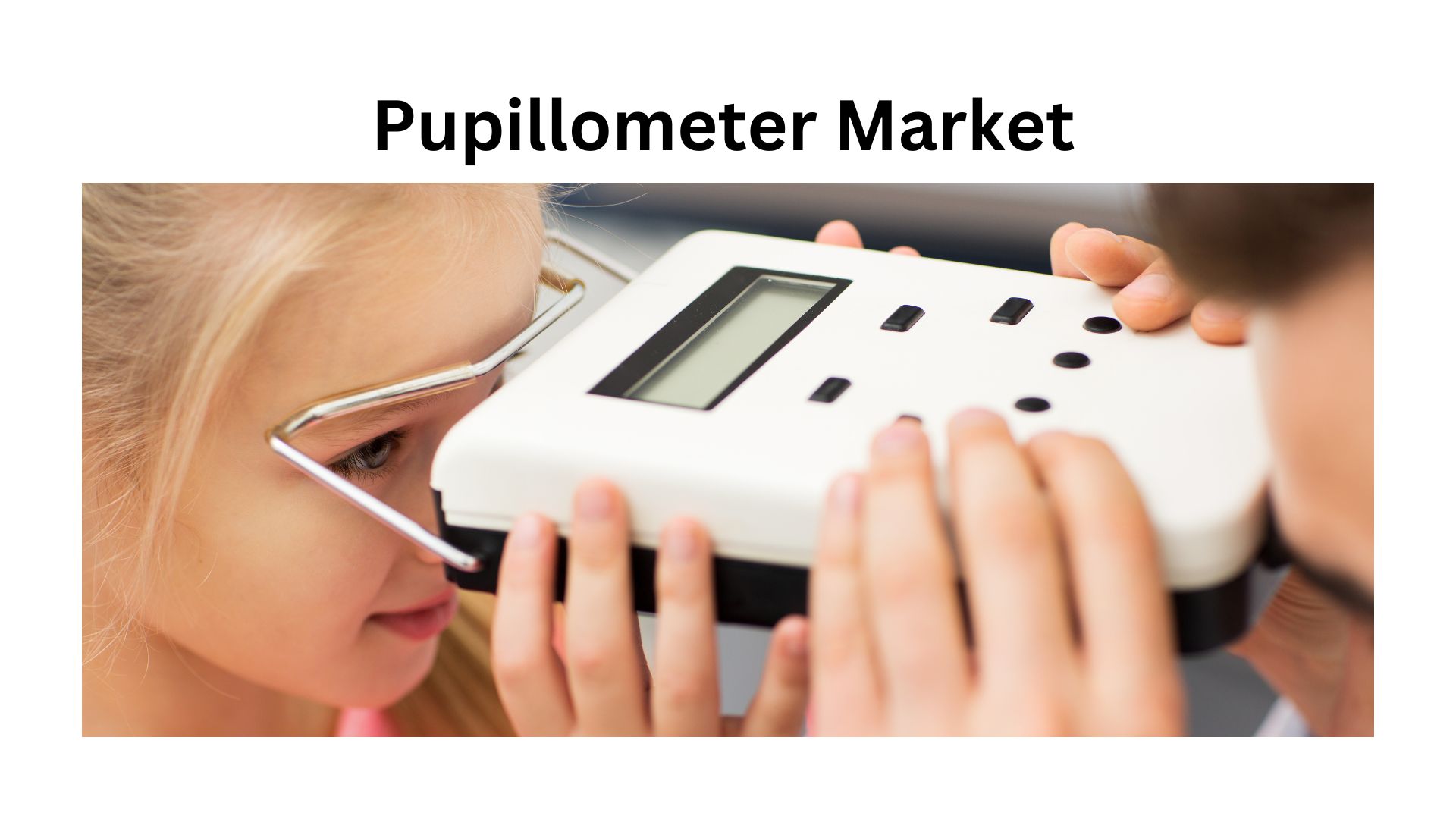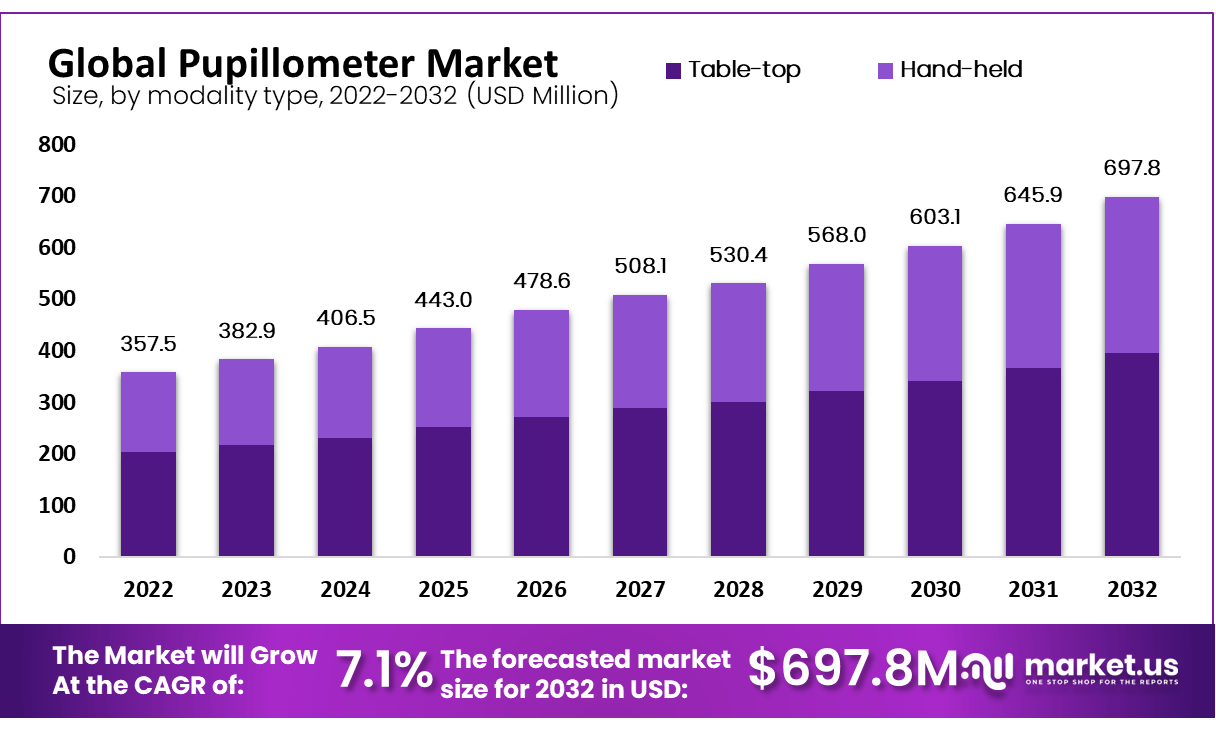Pupillometer Market Sales to Top USD 697.8 Mn in Revenues by 2032 at a CAGR of 7.10% | Global Analysis by Market.us

Page Contents
Market Overview
Published Via 11Press : The pupillometer market is a highly specialized area of medical technology that focuses on measuring the size and reaction of the pupils. Pupillometers are essential tools for diagnosing neurological conditions such as traumatic brain injury, stroke, and glaucoma. With advancements in technology, pupillometers have become more precise and easier to use, allowing for faster diagnoses and better patient outcomes.
The Global Pupillometer Market size is expected to be worth around USD 697.8 Million by 2032 from USD 357.5 Million in 2022, growing at a CAGR of 7.10% during the forecast period from 2023 to 2032.
One of the key drivers behind the growth of the pupillometer market is an aging population that is more susceptible to neurological disorders. Additionally, awareness about neurological conditions has increased in recent years due to high-profile cases such as concussions in sports, leading to greater demand for diagnostic tools like pupillometers.

Key Takeaway
- Modality-wise, tabletop held the greatest market share.
- By type, video market has the largest projected share with 58% projected market share projection.
- Regarding applications by use, eye segment products hold the largest market share with 51 percent during the forecasted period.
- Hospitals are projected to lead the worldwide pupillometer market by 22%.
- North America had taken an impressive 29.3 percentage part share in the global pupillometer market by 2022.
- APAC APAC is predicted to experience the highest compound annual growth among all regions.
Request For Sample Report Here: https://market.us/report/pupillometer-market/request-sample/
Regional Snapshot
- North America: North America and, in particular, the United States, has been an important marketplace for pupillometers. This region is well-established with a solid health system and state-of-the-art research facilities, and the focus is on the latest medical advances. A large number of companies and the high incidence of diseases such as brain trauma can contribute to the growth of markets in the region.
- Europe: Europe has also seen a significant increase in the use of pupillometers. Countries such as Germany, as well as Germany, the United Kingdom, France, and Italy, are equipped with modern healthcare infrastructure, research institutes, and a huge demand for devices to assess pupil size. A growing focus on ophthalmic disorders, neurological issues, as well as crucial care is driving the development of markets in this region.
- Asia Pacific: The Asia Pacific region is seeing significant growth in the healthcare industry, with the introduction of pupillometers. States like China, Japan, South Korea, and India are home to a huge number of patients, growing healthcare expenditures, and increasing importance on neuro- and ophthalmic healthcare. This is a major reason for the expanding market for the region.
- Latin America: Latin America is an exciting region for pupillometer. States like Brazil, as well as Mexico, are experiencing rapid growth in their health infrastructure, a growing awareness of pupillary testing in hospitals, and increasing investment into medical technologies. The growth of the market of this region is driven by the need for better medical diagnostics and monitoring for patients.
- Middle East and Africa: The Middle East and Africa region is progressively adopting pupillometers mostly due to advancements in health infrastructure and growing spending on medical equipment. States like Saudi Arabia, the United Arab Emirates and South Africa have shown potential for expansion in their markets because of the increasing attention to quality in healthcare as well as advances in neurology and other critical healthcare.
Drivers
- Increasing prevalence of neurological disorders: Neurological disorders, such as traumatic brain injuries, strokes, and glaucoma, often require pupillary assessment for diagnosis and monitoring. The rising incidence of these conditions drives the demand for pupillometers in healthcare settings.
- Growing awareness about pupillary assessment: There is an increasing awareness among healthcare professionals about the importance of pupillary assessment in critical care, ophthalmology, and neurology. The recognition of pupillary response as a valuable diagnostic tool fuels the demand for pupillometers.
- Technological advancements: Advancements in technology have led to the development of more sophisticated and accurate pupillometers. Features like digital imaging, real-time monitoring, and automated analysis improve the efficiency and reliability of pupillary assessment, contributing to market growth.
- Aging population: The aging population is more susceptible to conditions that require pupillary assessment, such as cataracts, macular degeneration, and neurological disorders. The growing elderly population worldwide is a significant driver for the pupillometer market.
- Increasing adoption in research and clinical trials: Pupillometers are extensively used in research studies and clinical trials to assess the effects of drugs, evaluate treatment outcomes, and monitor patients' pupillary responses. The growing number of research activities and clinical trials drives the demand for pupillometers.
Restraints
- High cost: Pupillometers can be expensive, particularly those with advanced features and functionalities. The high cost of these devices can limit their adoption, especially in healthcare facilities with budget constraints.
- Limited awareness and expertise: Pupillary assessment techniques require specialized knowledge and training. The limited availability of healthcare professionals with expertise in pupillary assessment can pose a restraint to the market, as proper utilization of pupillometers relies on skilled personnel.
- Challenges in standardization: The lack of standardized protocols and guidelines for pupillary assessment can create challenges in interpreting results and comparing data across different healthcare settings. The absence of uniform standards may hinder the widespread adoption of pupillometers.
- Data privacy and security concerns: Pupillometers that capture and store patient data may face challenges related to data privacy and security. Ensuring compliance with data protection regulations and maintaining the confidentiality of patient information can be a restraint for the market.
Opportunities
- Emerging markets: Emerging markets, particularly in Asia Pacific and Latin America, present significant growth opportunities for pupillometers. These regions have large populations, increasing healthcare investments, and a growing focus on neurological and ophthalmic care.
- Technological innovations: Continuous advancements in technology, such as portable and handheld pupillometers, integration with electronic health records (EHRs), and telemedicine capabilities, offer opportunities for market growth and expanded applications of pupillometers.
- Research and development: Ongoing research and development activities in pupillometry open up opportunities for the development of new and improved pupillometer devices. The introduction of innovative features, software algorithms, and data analytics can drive market growth.
Make an inquiry before picking up this report @ https://market.us/report/pupillometer-market/#inquiry
Challenges
- Limited reimbursement coverage: The reimbursement landscape for pupillometers may vary across regions and healthcare systems. Limited reimbursement coverage or inconsistent reimbursement policies can hinder the adoption of pupillometers, particularly in certain healthcare settings.
- Ethical considerations: Pupillary assessment involves the collection of sensitive patient data, which raises ethical considerations regarding data privacy, informed consent, and the appropriate use of patient information. Addressing these ethical challenges is crucial for the market's acceptance and growth.
- Regulatory requirements: Pupillometers may be subject to regulatory requirements, particularly in terms of safety and accuracy. Adhering to regulatory guidelines and obtaining necessary approvals can be a challenge for manufacturers, particularly in different regions with varying regulatory frameworks.
- Competition and market consolidation: The pupillometer market is relatively competitive, with several established players and new entrants. Intense competition and market consolidation can pose challenges for smaller companies trying to enter or expand their market presence.
Key Market Players
- NeurOptics Inc.
- Adaptica
- Essilor Instruments USA
- HAAG-STREIT GROUP
- Johnson & Johnson Vision
- Luneau Technology Group
- NIDEK CO. LTD.
- Reichert Technologies
- SCHWIND eye-tech-solutions
- US Ophthalmic
- Konan Medical
- Brightlamp Inc.
- Other Key Players
Key Market Segments
Based on Modality Type
- Table-top
- Hand-held
Based on Type
- Video
- Digital
Based on Application
- Ophthalmology
- Neurology
- Oncology
- Other Applications
Based on End-User
- Hospitals
- Eye Clinics
- Other End-Users
Top Impacting Factors
- Prevalence of neurological and ophthalmic disorders: The prevalence of neurological and ophthalmic disorders, such as traumatic brain injuries, strokes, glaucoma, and pupillary abnormalities, directly drives the demand for pupillometers. The incidence and severity of these conditions impact the adoption of pupillometers for diagnosis, monitoring, and treatment purposes.
- Technological advancements: Advances in technology play a crucial role in shaping the pupillometer market. Technological innovations, such as digital imaging, real-time monitoring, automated analysis, and integration with electronic health records (EHRs), enhance the accuracy, efficiency, and usability of pupillometers. The availability of advanced features and functionalities drives market growth.
- Increasing awareness and adoption: Growing awareness among healthcare professionals about the importance of pupillary assessment in various medical specialties contributes to market growth. The recognition of pupillary response as a valuable diagnostic and monitoring tool, along with the dissemination of educational resources and training programs, encourages the adoption of pupillometers.
- Aging population: The global aging population is a significant factor driving the pupillometer market. As individuals age, they are more prone to neurological and ophthalmic conditions that require pupillary assessment. The increasing number of elderly individuals worldwide creates a higher demand for pupillometers in healthcare settings.
- Research and clinical applications: Pupillometers are extensively used in research studies, clinical trials, and academic research. Their application in assessing the effects of drugs, evaluating treatment outcomes, and monitoring patients' pupillary responses fuels the demand for pupillometers. The expansion of research activities and the need for objective and quantitative data drive market growth.
Recent Developments
- In July 2021, NeurOptics Inc. received FDA clearance for its latest Neurological Pupillometer, a device that measures the neurological status of critically ill patients by analyzing the pupillary light reflex.
- In September 2021, Luneau Technology Group acquired Visionix, a leading provider of advanced eye diagnostic solutions, to expand its product portfolio & strengthen its global presence.
Report Scope
| Report Attribute | Details |
| The market size value in 2022 | USD 357.5 Mn |
| Revenue Forecast by 2032 | USD 697.8 Mn |
| Growth Rate | CAGR Of 7.10% |
| Regions Covered | North America, Europe, Asia Pacific, Latin America, and Middle East & Africa, and Rest of the World |
| Historical Years | 2017-2022 |
| Base Year | 2022 |
| Estimated Year | 2023 |
| Short-Term Projection Year | 2028 |
| Long-Term Projected Year | 2032 |
Frequently Asked Questions
Q: What is the current size of the pupillometer Market?
A: The Global pupillometer Market size is USD 357.5 Mn in 2022.
Q: What is the projected growth rate for the pupillometer Market?
A: The pupillometer Market is expected to grow at a CAGR of 7.10% from 2023 to 2032.
Q: What are some of the key players in the pupillometer Market?
A: Some of the key players in the pupillometer market include NeurOptics Inc., Adaptica, Essilor Instruments USA, HAAG-STREIT GROUP, Johnson & Johnson Vision, Luneau Technology Group, NIDEK CO. LTD., Reichert Technologies, SCHWIND eye-tech-solutions, US Ophthalmic, Konan Medical, Brightlamp Inc., Other Key Players.
Contact:
Global Business Development Team – Market.us
Market.us (Powered by Prudour Pvt. Ltd.)
Send Email: [email protected]
Address: 420 Lexington Avenue, Suite 300 New York City, NY 10170, United States
Tel: +1 718 618 4351
Website: https://market.us
Content has been published via 11press. for more details please contact at [email protected]
The team behind market.us, marketresearch.biz, market.biz and more. Our purpose is to keep our customers ahead of the game with regard to the markets. They may fluctuate up or down, but we will help you to stay ahead of the curve in these market fluctuations. Our consistent growth and ability to deliver in-depth analyses and market insight has engaged genuine market players. They have faith in us to offer the data and information they require to make balanced and decisive marketing decisions.